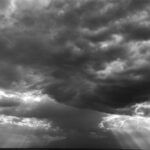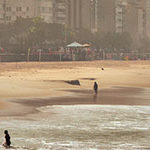
Outdoors, sunlight shows crisp edges, creates dimensional shapes, reveals textures and outlines silhouettes. The color differences between direct sunlight and light from the open sky intensifies the feeling of outdoors, though this effect must be used with discretion. A cloudy day usually portrays a somber mood, lighting everything with a top-weighted blue cast. A warming filter changes the blue mood to one of happier emotions.
Indoors, the light from a window is very shape-revealing in nature. Care must be taken to provide light on the shadow side in order to balance the picture. A blue sky as a source must be warmed up with a filter (80A) when using outdoor film. Sunlit clouds are a perfect source of light for your window pictures. Incandescent light is much warmer and must be used carefully. When incandescent light is used, a cooling filter (81B) will prevent the photograph from appearing too orange. Fluorescent lights are lacking in red may not portray skin tones properly.
The width of the light source must be taken into consideration. The widest possible light source is the wrap-around effect of a cloudy day at the beach. Round shapes are flattened, detail is obscured, and areas of similar color are often presented monochromatically. A point source like the sun or a light bulb throws sharp shadows and will emphasize small detail. Every effect of light can be used as a tool to further the aims of the artist. If there is a special effect which is necessary to the message within the composition, the photographer must wait for that perfect time and weather. Medium wide sources of light are desirable for their flattering, yet shape-revealing effect on the human face.
Practically, when outside, look for a white wall sit by the sun with a shaded area nearby. A low reflector like a sunlit patch of concrete, a beach, a light colored car, or anything with an appreciable area which will reflect light makes a good source of light. Unless wanted, make sure the surface is not too far from white, or the subject will take on that color.

There are certain combinations of light that has proven itself in the world of photography and art. Food often is photographed with a broad source of light straight toward the camera, just missing being in the picture. The human face is most flattered with a soft light at a 30 degree angle to the right or left of the camera and slightly above the lens, (sometimes referred to as a loop light). The “north” light of painter fame presented an unchanging source of light whose direction was controlled with movable drapes. Unfortunately, the built-in flash used by millions of photographers, while lighting the subject evenly, flattens the three dimensional subject, hiding the true roundness of shape. Occasionally in your travels, you may come across a quality of light which strikes a chord in your brain as being perfect for you photograph. Try to place this effect in your permanent memory for future use. Happy shooting.
Luck is recognizing the moment of opportunity. Comments welcome.
Like This Article?
Don't Miss The Next One!
Join over 100,000 photographers of all experience levels who receive our free photography tips and articles to stay current:






Leave a Reply